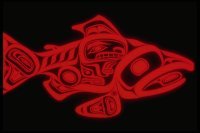 |
Glossary |
| |
 |
Fishing Techniques |
 |
Fish Processing Techniques |
|
(** Throughout this section, click on the upper left icon to return
here,
the Technology Main page **)
Salmon have been a mainstay of the Pacific Coast economy for thousands of years. Their
seasonal movements and migrations have been eagerly anticipated by generations of fishermen
who have depended upon the annual harvest of salmon for their survival.
Haida Dog Salmon. © Bill Reid.

|
First Nations fishermen developed sophisticated and efficient technologies which permitted
the large scale harvesting and processing of salmon. There were strict rules concerning this
harvesting and processing. First Nations peoples believed that the salmon had to be treated with
proper respect, or the runs, on which they depended, would not return again. The Lekwiltok
peoples of Quadra and Campbell River, like other First Nations peoples of the Northwest Coast,
understood the habits
and life cycle of the salmon. They were skillful and ingenious
fishermen who used harpoons, spears, gaffs, weirs, traps, hooks and lures, and
seine and gill nets as means of
catching salmon.
Commercial fishing boats docked.
©
Campbell River Museum Archive Image #4212.

|
Early European fishermen adopted many of these same techniques, as well as bringing new
technology and materials for manufacturing fishing gear to the industry. By 1864, an
international market for salmon had been established in British Columbia. This spawned the
beginning of a competitive commercial fishing market, which saw the spread of canneries up
and down the BC coast.
Within this atmosphere, the sport fishing industry developed. Now, not only were fishermen
fishing for food or their livelihood, but some were also fishing for the pure enjoyment and thrill
of catching a spectacular Tyee or Chinook. Sports fishermen
from Europe and England began coming to Campbell River to fish as early as the 1880's. Men
such as Sir Richard Musgrave and Sir John Rogers brought stories of their fishing expeditions
home with them. By passing their tales on to other fishermen, or writing about them in their
local sports magazines, these men attracted other fishermen to the area. These people, and others
like them, were the first pioneers of the sports fishing industry in this area. When the world
renowned Campbell River Tyee Club was born in 1924, even more fishermen were attracted to
Campbell River to fish. E.P. Painter, among others, helped to further propel the sports fishing
industry in Campbell River, with his creation of the
Tyee Boat, and his popular fishing lodge, Painter's Lodge.
A photo of early sports fishermen in the Campbell River
area, taken in 1889. © Campbell River Museum Archive Image #11490.

|
In addition to fishing for the great Tyee, many a fishermen also sought the coho and spring
salmon. Fly-fishing is an art that uses immense skill and technique to catch a coho, steelhead, or
cutthroat trout. People sportfish for many reasons. The challenge and the thrill of the catch is
what draws many a fisher to the sport. As one can see, the salmon is a part of a fisher's being.
Salmon touches all aspects of many people's lives along the Northwest Coast.
Top of page.
|



